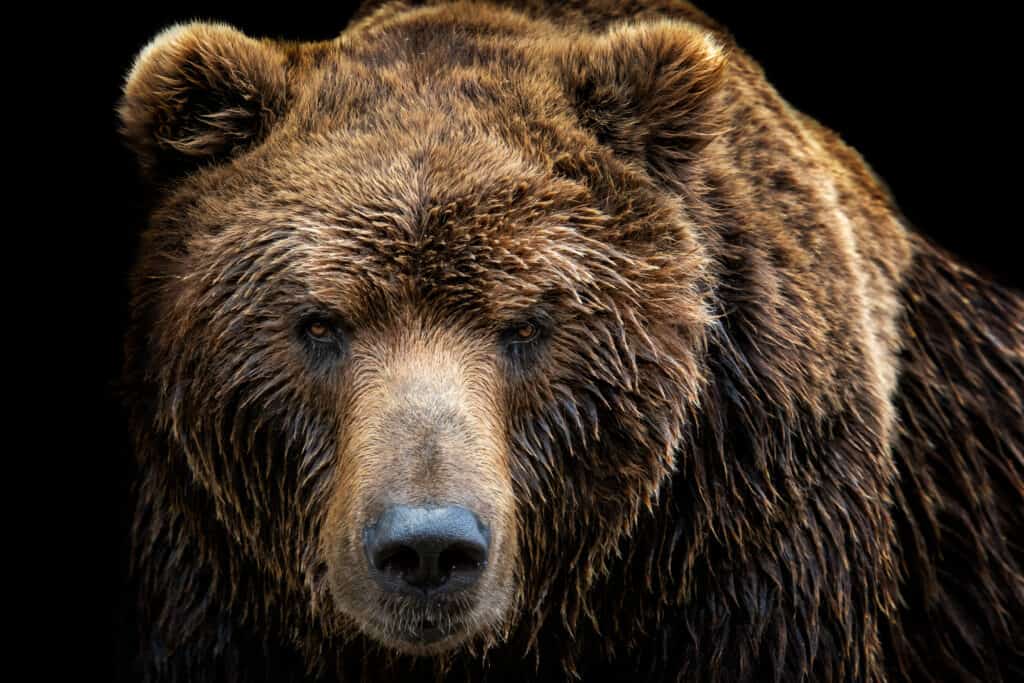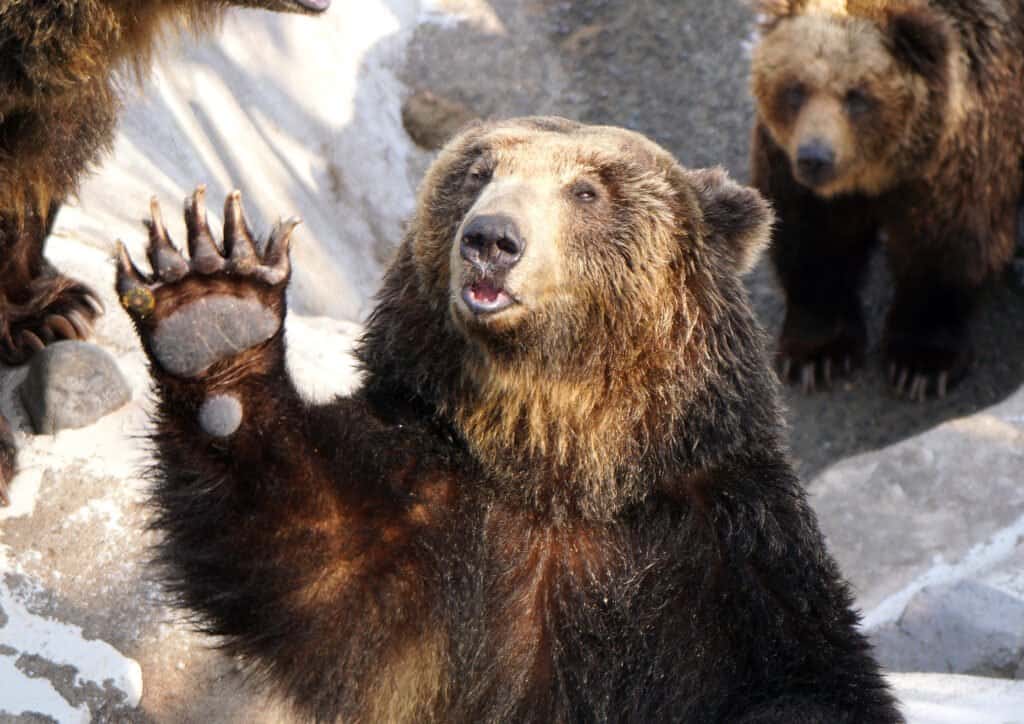Grizzly bears are among the most intelligent animals in North America and the world.
A small handful of North American land mammals top the grizzly bear in size, and two of those species are bears. The Grizzly is smaller than its northern cousins, the Kodiak and polar bears, but as we’ll learn today, size isn’t everything.
All species of bears, intimidating as they might be, have large brains in proportion to their body size. Their brains are more extensive than most land mammals, and their abilities place them among the likes of the great apes when it comes to intelligence.
Typically left out of discussions surrounding the intelligence of animals, things are starting to change. So, should we reassess the Grizzly bear’s intelligence? Should this animal be named the most brilliant predator in the world? Let’s dive in.
How Can We Gauge Intelligence?

Grizzly bears are exemplary omnivores.
©Lubos Chlubny/Shutterstock.com
Human intelligence is traditionally measured by how well a person can complete tasks or process information compared to the “average person.” We tend to think of math, science, and art as the hallmarks of human intelligence.
That said, thinking of intelligence in such narrow terms might not be very useful. There’s a lot more to life, and there are myriad ways for a person to express intelligence.
When thinking of animal intelligence, it’s important to recognize that a creature’s cognitive ability isn’t measured by how “human” it behaves or how many of our tasks it can perform. There are infinitely more ways to express intelligence in the animal kingdom, and many are distinctly non-human.
Think of an octopus changing colors like a kaleidoscope to evade predators. Or perhaps about the birds capable of spotting bugs in the dirt from incredible distances. Think of a Grizzly bear sniffing out the faintest note of a berry from miles away. These are also forms of intelligence.
While there isn’t an objective answer to measuring intelligence, let’s try thinking about creativity, functionality, and learning.
How creative can the Grizzly bear be when finding solutions to problems? How well does the bear’s brain allow it to function effectively? Finally, can Grizzly bears learn nuanced information and process it?
When you think in these terms, you can appreciate bear intelligence on a few new levels.
Bruins Aren’t Brutes
Let’s start by shaking off a dusty myth about bears.
The idea that Grizzly bears are objectively mean and vicious is outdated. The name “bruin” is now used to describe someone acting like a brute, but the term originally referred to bears. An association with brutishness is one thing that keeps us from appreciating Grizzly bear’s intelligence. It blinds us from looking at them objectively.
That stigma becomes clear when we share a space with wild bears. Any trek through a Grizzly habitat, however significant, is sure to have your hair standing up at one point or another.
It’s wise to keep a healthy distance from these animals, but it’s not necessary to be terrified of them. Grizzly bears don’t hunt humans as a viable prey source.
They might behave errantly if they’re starving, threatened, startled, or scared, however. It’s in those instances that a bear could become aggressive. Still, Grizzlies aren’t getting a whiff of your sweat and instantly tracking you down.
Fortunately, we aren’t their meal of choice. They’d much rather go peacefully, scanning the environment for seasonal berries, plants, fish, and other animals. They’re equipped with a deep arsenal of tools to pick and choose their next meals.
The process of finding food is a great place to start looking at markers of intelligence.
Could Grizzly Bears be the Smartest Predators due to their Omnivorous Wit?
Grizzly bears are exemplary omnivores. Omnivorous diets push animals to learn and understand their environment on numerous levels that more selective eaters don’t need to worry about.
They eat a wide array of plants, insects, and animals. Their intelligence is expressed in the varied ways they obtain food.
Here are some common food sources for Grizzlies:
- roots
- bugs
- carrion
- elk
- moose
- deer
- caribou
- rodents
- sheep
- salmon
- shrubs
- berries
- beehives
90% of their diets consist of vegetation, but the other 10 percent of their food shows us how adaptable they are. Adaptability suggests that bears are capable of considerable skills, each requiring intelligence.
Think of the planning to hunt down an elk or a caribou. The journey could stretch for miles through mountainous terrain, across streams, and in an ever-shifting highway of scents blown by the wind. Trained human hunters track elk for long distances for sport, and many come home unsuccessful.
Grizzlies are so attuned to their environment that they can navigate these factors in search of food. Along the way, they identify edible berries, roots, insects, and more to snack on. Even more impressive are the bear’s abilities to catch salmon.
When was the last time you saw a human with the dexterity to sit on the edge of a rushing river and catch leaping salmon with their mouth?
Home Range & Social Structure
The food Grizzlies eat is mostly confined to their personal territories.
A Grizzly bear might establish a “home” territory of around 500 square miles. If there are few bears in the area, that space might be larger. Bears are extremely aware of the food sources in that massive territory. They can remember finding a particular type of food in a specific location after ten years or more.
They develop a deep understanding of their range and stake that range out with their scent. While Grizzlies are largely solitary, the borders of their home ranges are a touching point for their social intelligence, which fixates on hierarchies.
When they’re taken from the wild, Grizzlies show us that their intelligence isn’t limited to the wilderness.
Trained Bears Can Do a Great Deal

Grizzly bears could be the smartest predators because they are some of the most adaptable and capable animals on the planet.
©VANESSAL/Shutterstock.com
Bears are often trained to do incredible things. Training captive bears is, however, unethical.
That said, the evidence of what bears can do when trained is proof of significant intelligence. While performing rote tasks isn’t a definite sign of intelligence, it suggests that there’s more between their ears than we once thought.
Riding bicycles, playing instruments, balancing on balls, and dancing while standing on hind legs aside, the ability to learn and remember specific tasks stands out in the animal kingdom. Few animals are trainable in this way, particularly animals that aren’t domesticated.
Dogs, for example, can do a great number of things. Bears are believed to be more intelligent than most dogs, but dogs have been domesticated for thousands of years.
Their biology evolved alongside ours for roughly 32,000 years. We also bred out traits like aggression, bred for intelligence. Generally, we curated dogs into a new species exceptional at living and working with us. That could be why they’re more prone to perform human-like tasks.
Bears, on the other hand, are genetically wild animals. They don’t have mirroring genes because they didn’t evolve alongside us. Not only that, but they are apex predators that can effortlessly maul humans.
Many trained bears end up getting revenge on their trainers, but most do not. Further, countless people have raised Grizzlies and lived with them in relative harmony.
Could Grizzly Bears be the Smartest Predators? Let’s Look at Cooperation
The willingness to spend time with and learn about another species reflects another level of intelligence. Mammals ignite the hippocampus when they’re curious, which is the area of the brain that deals with short-term and long-term memory, among numerous other things.
Higher-order thinking is fueled in large part by the neocortex. Bears are outliers regarding the size of the neocortex in relation to brain mass. As a group, bears stand out above the rest.
The greatest outlier is the polar bear, but grizzlies also have large neocortexes. The neocortex is the largest part of the frontal lobe. It’s divided into four categories on either hemisphere: frontal, parietal, temporal, and occipital.
Another aspect of the neocortex is the cerebral cortex, which is responsible for some of the higher functions of consciousness, such as thinking and reasoning. There’s still a lot to learn about the size and function of Grizzly bear brains, but it’s clear that they have more brain mass to work with than most land mammals.
That might be part of the reason that they can skirt our defenses more effectively than most other animals can. Those big brains contribute to a very precise knack for situational awareness.
Situational Awareness
Humans have laid waste to Grizzly bear populations, decimating 98% of their habitat in the continental United States and stripping their population down to a similar size. Humans are a threat, even when they don’t intend to be.
For example, bears that get too comfortable taking food or walking near humans in national parks are often relocated or put to sleep. There’s too great a chance that the bear will return, break into cars or tents, and pose a risk to visitors.
When bears get too close, people get scared, bears get scared, and deadly encounters happen. Part of the reason people can’t deter the bear is that they’re often smarter than the deterrent.
For example, most animals won’t return to an environment that’s been hostile to them. Bears in human environments are typically met with horns, shouts, pellets, and more.
Rather than identifying the area as hostile, bears recognize that humans are shooting bags or blazing horns. They’re clever enough to understand the situation and work with it. They still come back for food, but they return at a different time when nobody’s there.
That’s why bears are often relocated rather than deterred. They’ll come back and start scavenging the minute we turn our backs, so it isn’t enough to send them away.
So, could Grizzly Bears be the Smartest Predators?
Grizzlies should be recognized among the smartest predators because they are some of the most adaptable and capable animals on the planet.
Chimps and elephants might be a little more sophisticated and human-like in their intelligence, but Grizzlies aren’t far behind.
In the natural setting, though, Grizzly bear intelligence could match up against just about any animal on earth. Incredible memory, deep situational awareness, the ability to hunt in numerous ways, and the physical prowess to stand out as apex predators are all traits that put Grizzly bears among the smartest animals on the planet.
What’s Up Next?
- Grizzly Bear
- Grizzly Bear Lifespan: How Long Do Grizzly Bears Live?
- Are There Grizzly Bears in Colorado?
The photo featured at the top of this post is © PhotoBarmaley/Shutterstock.com
Sources
- All Grizly, Available here: https://www.allgrizzly.org/intelligence
- New York Post, Available here: https://nypost.com/2021/07/19/circus-trainer-mauled-twice-by-bear-in-front-of-crowd/
- Fish and Wildlife Service, Available here: https://www.fws.gov/species/grizzly-bear-ursus-arctos-horribilis
- Frontiers in Neuroanatomy, Available here: https://www.frontiersin.org/articles/10.3389/fnana.2019.00079/full
- Cleveland Clinic, Available here: https://my.clevelandclinic.org/health/articles/23073-cerebral-cortex
- PBS, Available here: https://www.pbs.org/wnet/nature/arctic-bears-bear-intelligence/779/
Thank you for reading! Have some feedback for us? Contact the AZ Animals editorial team.






